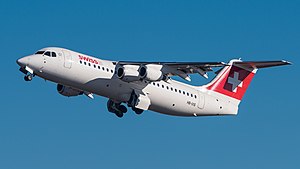BAe 146
| BAe 146 / Avro RJ | |
|---|---|
 |
|
| Swiss Global Air Lines Avro RJ100 | |
| Role | Airliner |
| National origin | United Kingdom |
| Manufacturer |
British Aerospace BAE Systems Avro International |
| First flight | 3 September 1981 |
| Introduction | May 1983 |
| Status | In service |
| Primary users |
CityJet Swiss Global Air Lines Brussels Airlines Airlink |
| Produced | 1978–2001 |
| Number built | 387 (Avro RJ: 166; BAe 146: 221) |
| Program cost | £350 million |
| Unit cost |
146-200: £11 million (1981)
|
|
|
The British Aerospace 146 (also BAe 146) is a short-haul airliner and a regional airliner that was manufactured in the United Kingdom by British Aerospace, later part of BAE Systems. Production ran from 1983 until 2002. Manufacture of an improved version known as the Avro RJ began in 1992. A further-improved version with new engines, the Avro RJX, was announced in 1997, but only two prototypes and one production aircraft were built before production ceased in 2001. With 387 aircraft produced, the Avro RJ/BAe 146 is the most successful British civil jet airliner programme.
The BAe 146/Avro RJ is a high-wing cantilever monoplane with a T-tail. It has four turbofan engines mounted on pylons underneath the wings, and has retractable tricycle landing gear. The aircraft has very quiet operation, and has been marketed under the name Whisperjet. It sees wide usage at small city-based airports such as London City Airport. In its primary role it serves as a regional jet, short-haul airliner or regional airliner. The BAe 146/Avro RJ is in wide use with several European-based airlines, such as Brussels Airlines, CityJet and Swiss Global Air Lines.
The BAe 146 comes in -100, -200 and -300 models. The equivalent Avro RJ versions are designated RJ70, RJ85, and RJ100. The freight-carrying version carries the designation "QT" (Quiet Trader), and a convertible passenger-or-freight model is designated as "QC" (Quick Change). A "gravel kit" can be fitted to aircraft to enable operations from rough, unprepared airstrips.
In August 1973, Hawker Siddeley launched a new 70 seat regional airliner project, the HS.146, to fill the gap between turboprop-powered airliners like the Hawker Siddeley HS.748 and the Fokker F.27 and small jet airliners like the BAC One-Eleven and Boeing 737. The chosen configuration had a high wing and a T-tail to give good short-field performance, while the aircraft was to be powered by four 6500 lbf thrust Avco Lycoming ALF 502H turbofan engines. There were several reasons why a twin engine configuration was not chosen. Certainly, a major factor would have been that no manufacturer was producing a 13000 lbf-thrust-class high bypass ratio turbofan engine at the time.
...
Wikipedia
